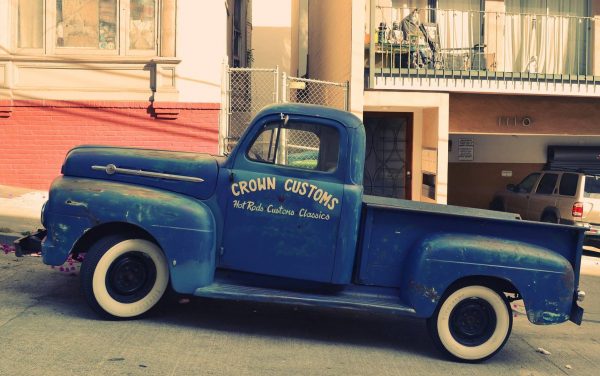Uphill
Starting moving, or pulling away, uphill is a tricky manouevre for learner drivers. The technique you adopt depends on whether you drive an automatic or manual vehicle and whether you have additional technology in your vehicle such as hill hold assist.
It can be made more challenging by new-style hydraulic handbrakes which operate by pushing a button rather than pulling up a handle or lever.

Older vehicles are more difficult to do hill starts in
Automatic
In an automatic car you will have your handbrake on. Apply some pressure to the throttle and release the handbrake. You should start moving forwards. If you start rolling backwards or you go nowhere, you’re not applying enough throttle; if you take off too quickly, then you’ve applied too much. You’ll get to know how much to apply through experience.
If you have hill hold technology which keeps the brakes on for up to a few seconds to stop you rolling backwards until you have enough throttle to start moving forwards, then your accurate use of the handbrake is not so critical.
Some cars with automatic handbrakes will release the handbrake as soon as you apply the throttle without you needing to press the button.
If you have a footbrake rather than a handbrake (many Hondas have these, for example), then you’ll need to coordinate releasing that with your left foot while you apply the throttle with your right foot.
Remember also that you should be checking your mirrors if you are in traffic, and if you are pulling into traffic then you should be indicating and checking over your shoulder, too.
Manual / stick shift
We’ve never seen a manual car with a foot-operated parking brake (but that’s not to say they don’t exist), and that’s probably because you need to be able to operate the clutch and handbrake at the same time.
- You need to set the vehicle up properly before moving away uphill. This means:
- ensuring the handbrake is on
- pushing the clutch in
- selecting the correct gear (which will almost always be first unless you’re driving a big lorry)
To get moving you’ll need to:
- apply some pressure to the throttle – get a couple of thousand revs at least and then keep your foot steady
- start bringing the clutch up until you feel it ‘biting’. At this point you should hear the engine tone change, too
- release the handbrake as you bring the clutch up slowly
- be prepared to give it slightly more or less throttle to adjust the revs to create a smooth transition. This is the bit that takes practice. Eventually you’ll be able to quickly feel whether you either have too many revs or if you have not enough and you’re about to stall.
- You might find that you need to keep the clutch slightly pushed down until your doing a few miles per hour to preven the vehicle from jumping and juddering; you don’t want to be doing ‘kangaroo starts’!
Finally, remember that you should be observing the mirror-signal-manoeuvre routine if you’re pulling into traffic, and you should be checking your mirrors if you are already in traffic.
Motorbikes
A motorbike hill start is tricky as you’ll select the gear while keeping the clutch lever in then put your left foot back on the ground for balance. Use the front brake to hold the bike in place. Give it some throttle and gradually release the clutch lever. As you feel it biting, balance the throttle and release the brake. As the bike starts moving forward you’ll be able to put your feet on the pegs and keep your balance.
If it’s a really steep hill, then you might need to use the back brake to hold yourself in place. This will reduce your balance because then you’ll only have one foot on the ground.
Downhill starts
Downhill starts are much easier. In a manual vehicle you can probably move away in second gear for a smoother start and better fuel economy. It’s not so critical that you get the revs perfect because gravity will do most of the work for you.
In an automatic vehicle you simply release the handbrake and the vehicle will start moving.
Be mindful that until you’re experienced you may need o be using the brake rather than the accelerator, especially if the downhill gradient is steep.
